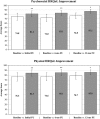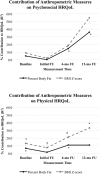Longitudinal quality of life improvement in underserved rural youth with obesity
- PMID: 28090350
- PMCID: PMC5192546
- DOI: 10.1002/osp4.82
Longitudinal quality of life improvement in underserved rural youth with obesity
Abstract
Objective: ACT! (Actively Changing Together) is a family- and community-based intervention targeting youth with obesity. The objective of this study was to establish the longitudinal impact on Health-Related Quality of Life (HRQoL) as well as the relationship with anthropometric and demographic factors.
Methods: Youth (n = 75) aged 8-14 years meeting criteria for overweight or obesity were referred to the programme. Twelve, 90-min classes in English and Spanish were held at the YMCA. Demographics and anthropometrics were assessed, as well as HRQoL that was measured with the child-reported Pediatric Quality of Life Inventory (PedsQL™) 4.0 Generic Core Scale. Data was collected at three follow-up points after completion of the intervention: initial follow-up (n = 65), 6 (n = 41) and 12 months (n = 25). Analysis included paired dependent t-tests between baseline and follow-up, and Pearson's correlations on HRQoL, anthropometric and demographic data.
Results: PedsQL scores significantly improved from baseline to all follow-up timepoints (initial follow-up immediately following the intervention, and 6 and 12 months post intervention). Over time, body mass index Z-Score and per cent body fat displayed various points of significance and strengthening correlations.
Conclusions: Longitudinal improvements in HRQoL were sustained up to 12 months following a family- and community-based intervention in this underserved population. Anthropometric measures continuously correlated with and contributed to HRQoL outcomes.
Keywords: Behavioural science; childhood obesity; lifestyle modification; quality of life.
Figures


References
-
- Skinner AC, Perrin EM, Skelton JA. Prevalence of obesity and severe obesity in US children, 1999‐2014. Obesity (Silver Spring) 2016; 24: 1116–1123. - PubMed
LinkOut - more resources
Full Text Sources
Other Literature Sources
